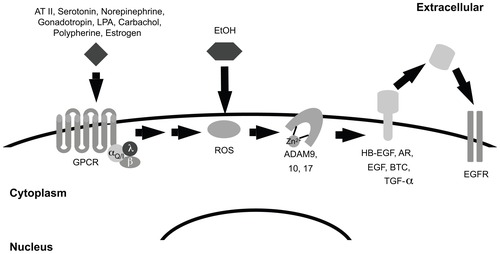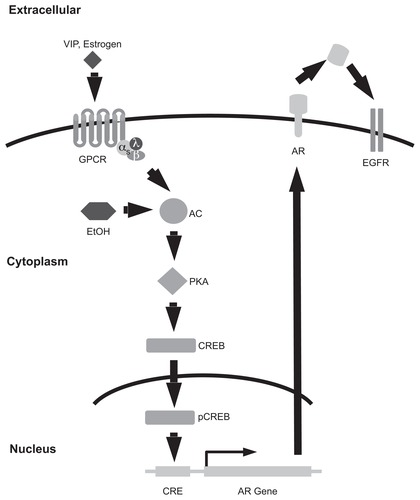Figures & data
Figure 1 Alcohol may mimic G-protein coupled receptor transactivation of EGFR. Signaling by Gq/i-coupled receptors contributes to the production of reactive oxygen species (ROS). These ROS oxidize a cysteine residue in the catalytic cleft of the ADAM, thereby disrupting the interaction between the zinc ion and the ADAM protein. Disruption of this interaction causes the ADAM protein to adopt an active conformation. Active ADAM proteins can then cleave the precursor form of EGF family growth factors. The cleaved factors bind EGFR and stimulate its signaling activity. Because alcohol causes intracellular accumulation of ROS, it is predicted to stimulate EGFR signaling.
Abbreviations: AT II, angiotensin II; LPA, lysophosphatidic acid; EtOH, ethanol; GPCR, G-protein coupled receptor; ROS, reactive oxygen species; HB-EGF, heparin-binding, EGF-like growth factor; AR, amphiregulin; EGF, epidermal growth factor; BTC, betacellulin; TGFalpha, transforming growth factor alpha; EGFR, EGF receptor.

Figure 2 Alcohol may mimic G-protein coupled receptor stimulated transcription of amphiregulin, an EGF family growth factor. Signaling by Gs-coupled receptors stimulates adenylate cyclase (AC) production of cAMP. This increases phosphorylation of the transcription factor CREB (cAMP response element binding protein) by protein kinase A (PKA). CREB promotes the transcription of the EGF family growth factor amphiregulin (AR), resulting in increasing EGFR signaling. Alcohol stabilizes AC in the active conformation, resulting in increased PKA activity. Thus, alcohol is predicted to stimulate AR transcription and EGFR signaling.
Abbreviations: VIP, vasoactive intestinal peptide; GPCR, G-protein coupled receptor; EtOH, ethanol; AC, adenylate cyclase; PKA, protein kinase A; CRE, cyclic AMP response element; CREB, CRE-binding protein; pCREB, phosphorylated CREB; AR, amphiregulin; EGFR, EGF receptor.

Figure 3 Alcohol may inhibit phosphatases that negatively regulate EGFR. The protein tyrosine phosphatase PTP-1B inhibits EGFR signaling by catalyzing the dephosphorylation of EGFR tyrosine residues. ROS can oxidize a catalytic cysteine residue of protein phosphatases, thereby inactivating them and leading to increased EGFR signaling. Because alcohol causes intracellular accumulation of ROS, it is predicted to stimulate EGFR signaling.
Abbreviations: EtOH, ethanol; ROS, reactive oxygen species; PTP-1B, protein tyrosine phosphatase 1B; EGFR, EGF receptor.
